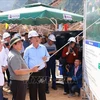 The 1,230m, four-lane, steel span bridge spans the Red River and connects Long Bien district with central Hanoi (Photo: Vietnam+)
The 1,230m, four-lane, steel span bridge spans the Red River and connects Long Bien district with central Hanoi (Photo: Vietnam+)  The original design of the bridge was estimated to accommodate 7,000 vehicles per day but then the number of vehicles increased by 3-4 times (Photo: Vietnam+)
The original design of the bridge was estimated to accommodate 7,000 vehicles per day but then the number of vehicles increased by 3-4 times (Photo: Vietnam+)  In the late 1990s, Chuong Duong bridge was constantly overloaded, causing Hanoi to build more rotation systems at the south of the bridge to relieve congestion of the directions of Tran Quang Khai and Tran Nhat Duat streets (Photo: Vietnam+
In the late 1990s, Chuong Duong bridge was constantly overloaded, causing Hanoi to build more rotation systems at the south of the bridge to relieve congestion of the directions of Tran Quang Khai and Tran Nhat Duat streets (Photo: Vietnam+  Chuong Duong bridge is one of the main bridges that moves traffic across the Red River in Hanoi (Photo: Vietnam+)
Chuong Duong bridge is one of the main bridges that moves traffic across the Red River in Hanoi (Photo: Vietnam+)  The 1.14km long and 55m wide Dong Tru bridge spans the Duong River and links Long Bien district and the suburban district of Dong Anh (Photo: Vietnam+)
The 1.14km long and 55m wide Dong Tru bridge spans the Duong River and links Long Bien district and the suburban district of Dong Anh (Photo: Vietnam+)  The Dong Tru arch bridge, made of steel tubes filled with cement, is part of the extended Highway No. 5 project (Photo: Vietnam+)
The Dong Tru arch bridge, made of steel tubes filled with cement, is part of the extended Highway No. 5 project (Photo: Vietnam+)  Long Bien bridge is a historic cantilever bridge across the Red River that connects two districts, Hoan Kiem and Long Bien of the city of Hanoi (Photo: Vietnam+)
Long Bien bridge is a historic cantilever bridge across the Red River that connects two districts, Hoan Kiem and Long Bien of the city of Hanoi (Photo: Vietnam+)  The bridge was built in 1899-1902 by the architects Daydé & Pillé of Paris, and opened in 1903 (Photo: Vietnam+)
The bridge was built in 1899-1902 by the architects Daydé & Pillé of Paris, and opened in 1903 (Photo: Vietnam+)  The bridge is for a single rail that runs in the middle, with two sides for motor vehicles and pedestrians (Photo: Vietnam+)
The bridge is for a single rail that runs in the middle, with two sides for motor vehicles and pedestrians (Photo: Vietnam+)  The bridge is seriously degraded and is being repaired to facilitate Hanoi-Lang Son rail route (Photo: Vietnam+)
The bridge is seriously degraded and is being repaired to facilitate Hanoi-Lang Son rail route (Photo: Vietnam+)  Nhat Tan bridge is a cable-stayed bridge crossing the Red River in Hanoi, inaugurated on January 4, 2015 (Photo: Vietnam+)
Nhat Tan bridge is a cable-stayed bridge crossing the Red River in Hanoi, inaugurated on January 4, 2015 (Photo: Vietnam+)  It forms part of a new six-lane highway linking Hanoi and Noi Bai International Airport. The project is funded by a Japan International Cooperation Agency ODA loan (Photo: Vietnam+)
It forms part of a new six-lane highway linking Hanoi and Noi Bai International Airport. The project is funded by a Japan International Cooperation Agency ODA loan (Photo: Vietnam+)  Nhat Tan Bridge has a total length of 8.3 kilometres, including a 3.7 kilometre bridge, with 1.5 kilometre cable-stayed bridge with five spans crossing the Red River (Photo: Vietnam+)
Nhat Tan Bridge has a total length of 8.3 kilometres, including a 3.7 kilometre bridge, with 1.5 kilometre cable-stayed bridge with five spans crossing the Red River (Photo: Vietnam+)  The bridge is 33.2 metre wide, divided into four lanes for motorized vehicles, two lanes for buses, two lanes for mixed vehicles and pedestrian paths. Each span has 11 pairs of cables (Photo: Vietnam+)
The bridge is 33.2 metre wide, divided into four lanes for motorized vehicles, two lanes for buses, two lanes for mixed vehicles and pedestrian paths. Each span has 11 pairs of cables (Photo: Vietnam+)  Nhat Tan Bridge was designed and built to become a new icon of the capital, its five towers symbolizing the five ancient gates of Hanoi. It also helps shorten time from Noi Bai International Airport to the city's centre (Photo: Vietnam+)
Nhat Tan Bridge was designed and built to become a new icon of the capital, its five towers symbolizing the five ancient gates of Hanoi. It also helps shorten time from Noi Bai International Airport to the city's centre (Photo: Vietnam+)  The bridge crosses the Red River at the location of km6 300 on Nam Thang Long Highway, connecting Noi Bai International Airport with the center of Hanoi (Photo; Vietnam+
The bridge crosses the Red River at the location of km6 300 on Nam Thang Long Highway, connecting Noi Bai International Airport with the center of Hanoi (Photo; Vietnam+  The steel truss bridge is 3,250 m long, consisting of 2 decks with the upper deck for road and the lower deck for railway and bicycles and pedestrians (Photo:Vietnam+)
The steel truss bridge is 3,250 m long, consisting of 2 decks with the upper deck for road and the lower deck for railway and bicycles and pedestrians (Photo:Vietnam+)  The Thanh Trì Bridge (completed 2008) is a bridge across the Red River in Hanoi. It was one of the Millennial Anniversary of Hanoi commemorative projects along with the Vĩnh Tuy Bridge (Photo: Vietnam+)
The Thanh Trì Bridge (completed 2008) is a bridge across the Red River in Hanoi. It was one of the Millennial Anniversary of Hanoi commemorative projects along with the Vĩnh Tuy Bridge (Photo: Vietnam+)  It is part of the Hanoi Third Ring Road, and is the largest prestressed concrete bridge in Vietnam (Photo: Vietnam+)
It is part of the Hanoi Third Ring Road, and is the largest prestressed concrete bridge in Vietnam (Photo: Vietnam+)  Vinh Tuy Bridge, one of seven bridges in Hanoi crossing the Red River, was inaugurated in 2010 (Photo: Vietnam+)
Vinh Tuy Bridge, one of seven bridges in Hanoi crossing the Red River, was inaugurated in 2010 (Photo: Vietnam+)  The work was ground-broken on February 3, 2005, using the total investment of nearly VND 3,600 billion in the first phase (Photo: Vietnam+)
The work was ground-broken on February 3, 2005, using the total investment of nearly VND 3,600 billion in the first phase (Photo: Vietnam+)  The bridge, consisting of eight spans and four lanes of 19.25 m wide, was completely constructed by Vietnamese engineers and workers (Photo: Vietnam+)
The bridge, consisting of eight spans and four lanes of 19.25 m wide, was completely constructed by Vietnamese engineers and workers (Photo: Vietnam+)  This key project helps to complete the planning scheme for Hanoi's ring road II and upgrade the city’s transport infrastructure (Photo: Vietnam+)
This key project helps to complete the planning scheme for Hanoi's ring road II and upgrade the city’s transport infrastructure (Photo: Vietnam+)  The bridge was recognized by Hanoi’s government as a project to welcome the millennium of Thang Long-Hanoi. It also won a gold medal from the Ministry of Construction for High Quality (Photo:Vietnam+)
The bridge was recognized by Hanoi’s government as a project to welcome the millennium of Thang Long-Hanoi. It also won a gold medal from the Ministry of Construction for High Quality (Photo:Vietnam+) VNA



























